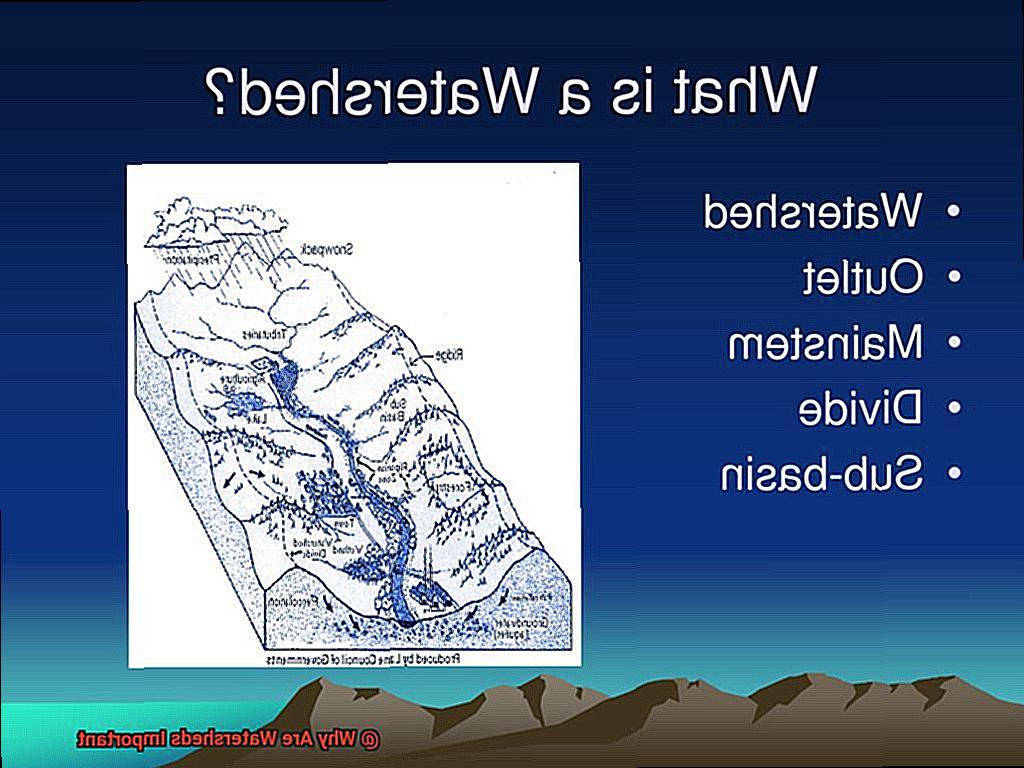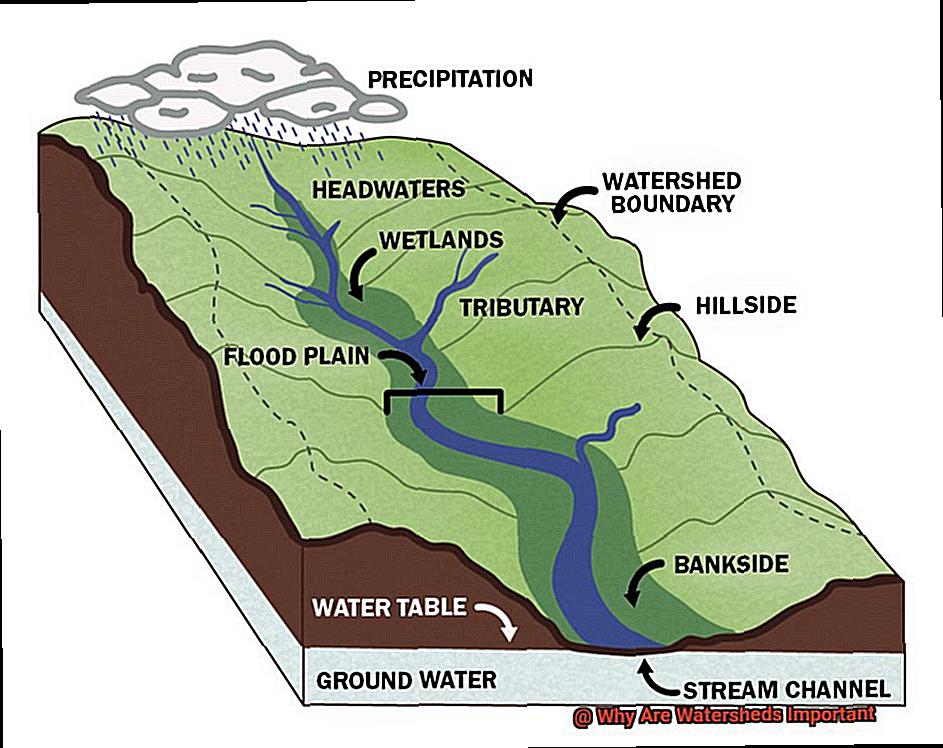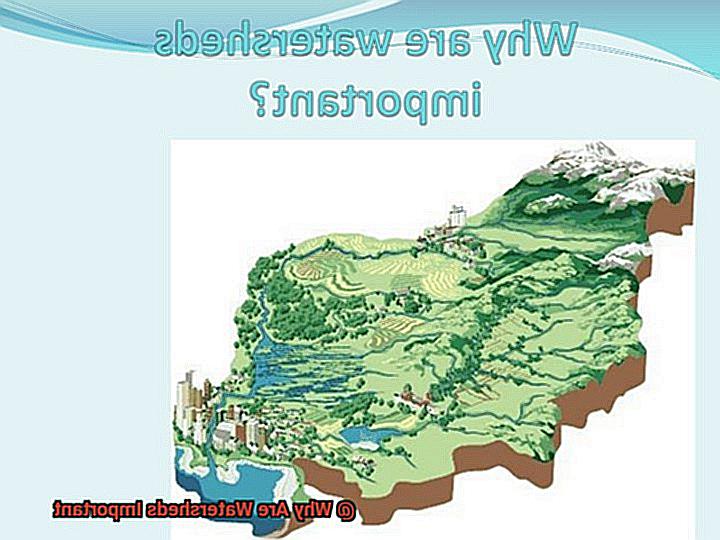When was the last time you stopped to ponder the water cycle? Perhaps it was during your school days, when you first learned about the process of evaporation, condensation, and precipitation. However, did you know that watersheds are responsible for initiating this crucial component of our planet’s ecosystem?
A watershed is simply an area of land that drains into a specific body of water like a river or lake. These bodies of water serve as vital sources of drinking water, aquatic habitats, and recreational activities for millions of people worldwide.
Watersheds also play a pivotal role in preventing water pollution. The land within a watershed acts as a natural filter, removing pollutants such as excess nutrients and sediment from the water as it flows towards the basin.
Unfortunately, our watersheds face unique challenges due to ongoing urbanization and climate change. Stormwater runoff and increased temperatures can lead to erosion and flash flooding while drought conditions threaten the availability of freshwater sources.
So next time you turn on your tap or take a dip in your local swimming hole, take a moment to reflect on the critical role that watersheds play in our daily lives. By comprehending the importance of these remarkable landscapes, we can work towards sustainable management practices and safeguard our planet’s most valuable resource.
The Importance of Watersheds
Contents
Watersheds are an invaluable part of our environment, and it’s essential to understand their significance in preserving our planet. At its core, a watershed is simply a land area in which all surface and groundwater flows into a single body of water, such as a river, lake, or ocean. However, the impact of watersheds on our world is far-reaching and crucial.
One of the most critical functions of watersheds is their natural ability to filter and clean water. As water flows through the land in a watershed, it undergoes a process of filtration through plants, soil, and other materials. This process removes pollutants and sediment from the water, making it cleaner and safer for humans, wildlife, and aquatic life. Watersheds also play a vital role in preventing erosion and flooding.
In addition to filtering water, watersheds provide habitat for a diverse range of wildlife. They offer a variety of habitats such as wetlands, forests, grasslands, and rivers that support countless species of plants and animals. From fish to birds to mammals, many species rely on healthy watersheds for their survival. When we protect the health of watersheds, we are also protecting the habitats of countless species.
Watersheds are also essential for our own well-being. They provide us with drinking water that over 200 million Americans rely on every day. Additionally, they are used for irrigation purposes that help grow crops and ensure our food supply. Watersheds also offer recreational opportunities such as fishing and boating that enrich our lives.

The significance of watersheds cannot be overstated. They filter our water naturally, provide habitats for wildlife, and support our livelihoods. They also play a critical role in regulating the Earth’s climate by absorbing carbon dioxide from the atmosphere, mitigating climate change effects, and reducing the impact of extreme weather events.
It’s easy to take watersheds for granted, but we must remember their importance in preserving our environment. By taking care of our watersheds, we are taking care of our planet and ourselves.

Watersheds and Water Supply
Watersheds are the unsung heroes of the water supply system, silently working behind the scenes to keep us hydrated and healthy. These areas of land that drain into a particular body of water are the beating heart and breathing lungs of our environment, constantly moving and filtering water to ensure that our freshwater resources remain abundant and clean.
Picture watersheds as natural Brita filters, absorbing and filtering pollutants from runoff before they reach our drinking water sources. Without these natural filters, our water supply would be susceptible to contamination from harmful chemicals and substances. Moreover, watersheds help regulate the flow of water during dry spells or periods of heavy rainfall, reducing the risk of flooding and erosion.
However, watersheds have more to offer than just functional benefits. They are bustling ecosystems that support a diverse range of plant and animal life. This makes them an essential part of our natural world, offering habitats for wildlife and supporting biodiversity by providing clean water and healthy environments for creatures from tiny microorganisms to majestic bald eagles.
And let’s not forget about the recreational opportunities that watersheds provide. They offer a chance to connect with nature through fishing, swimming, boating, and hiking. They are an important part of our cultural heritage that allows us to experience firsthand the beauty that nature has to offer.
So, how can we protect and conserve these precious resources? It starts with being mindful of our actions and their impact on the environment. Simple steps like properly disposing of hazardous waste, reducing our use of chemical fertilizers and pesticides, and conserving water can make a significant difference in preserving the health of our watersheds.
We all play an essential role in ensuring that we have access to clean water for generations to come. By recognizing the importance of watersheds in our daily lives and taking steps to protect them, we can ensure a healthy future for ourselves, our communities, and the environment.
Watersheds and Climate Regulation
Watersheds are like the guardians of the Earth’s ecosystems. They store and distribute water, which is vital for maintaining a balance in our planet’s natural systems. By absorbing carbon dioxide from the atmosphere through photosynthesis, they act like superheroes fighting against harmful greenhouse gases and reducing their negative impact on our planet.
But watersheds have more tricks up their sleeves: they also play a crucial role in regulating temperature. By providing shade and releasing water vapor through transpiration, forested watersheds cool down the surroundings, preventing extreme weather events such as heatwaves and droughts. They’re like a natural air conditioner that keeps us comfortable and safe.
Moreover, watersheds are vital for regulating water cycles. During times of excess water, such as heavy rainfall or snowmelt, watersheds act as natural reservoirs by storing the extra water and preventing downstream flooding. During periods of drought or low rainfall, stored water is released to maintain stream flow and support aquatic ecosystems. Watersheds are like a giant water management system that keeps everything in balance.
In conclusion, watersheds are essential for maintaining a healthy and stable climate. They tirelessly work behind the scenes to support the planet’s ecosystems by regulating temperature, water cycles, and carbon dioxide absorption. Let’s all do our part to protect these amazing natural resources and ensure a bright future for ourselves, our communities, and our planet.
Watersheds as Habitats for Wildlife
Watersheds are more than just bodies of water. They are bustling metropolises for wildlife, providing a diverse range of habitats to suit the needs of many different species. From the tiniest insects to the largest mammals, watersheds provide essential resources that keep wildlife thriving.
One of the most important resources that watersheds offer is clean water. Many animals rely on watersheds as a source of drinking water, and also use the water for bathing and other activities. Fish species like trout, salmon, and bass depend on clean watersheds for their survival, while amphibians like frogs and salamanders need the moist environment of watersheds for breeding and shelter.
Beyond water, watersheds also provide shelter and protection for wildlife. The natural vegetation found in watersheds offers cover and nesting sites for birds and mammals, while wetlands provide habitat for many species of waterfowl and other water-loving animals. Reptiles like snakes, turtles, and lizards also call watersheds home.
But perhaps most importantly, watersheds offer a crucial source of food for many animal species. The diverse ecosystem found in watersheds supports a range of plant life, which in turn provides food for herbivorous animals. Predators like birds of prey and mammals like foxes and coyotes hunt in watersheds for their prey.
Watersheds are home to a variety of wildlife, including fish, amphibians, reptiles, birds, and mammals. Each species depends on the unique resources provided by these habitats to survive. By protecting and preserving these ecosystems, we can ensure that these vital habitats remain intact for future generations of animals to thrive in.
Watersheds are truly invaluable habitats for wildlife, providing everything from clean water to shelter to food. So let us all do our part to protect these incredible ecosystems and the countless species that call them home.
The Impact of Human Activity on Watersheds
It’s no secret that pollution is a significant threat to watersheds. Industrial and agricultural activities, as well as urbanization, result in the release of pollutants such as chemicals, fertilizers, pesticides, and sewage into waterways. Not only do these pollutants harm aquatic life, but they also contaminate our drinking water sources. It’s important to recognize that every action we take has a ripple effect on our environment and our health.
But pollution isn’t the only way human activity can affect watersheds. Land development and construction lead to increased runoff and erosion by removing vegetation or building roads or dams. This can lead to devastating consequences such as flooding or droughts, along with a decrease in water quality. We must be mindful of how our actions affect the natural flow of water and take steps to mitigate their impacts.
Another threat to watersheds is invasive species. Non-native plants and animals can disrupt the natural balance of an ecosystem, outcompeting native species for resources and altering food webs. This can have serious consequences for both the environment and human health. It’s crucial that we take action to control invasive species before they cause irreparable harm.
So what can we do to protect our precious watersheds? Implementing best management practices such as reducing pollution and erosion, restoring degraded habitats, and controlling invasive species are all critical steps we must take. Each one of us has a role to play in preserving these invaluable habitats for future generations.
How to Protect and Preserve Watersheds
Watersheds are the lifeblood of our planet, providing us with clean water, supporting diverse wildlife habitats, and regulating water flow. However, with increasing human activities such as urbanization, agriculture, mining, and deforestation, watersheds are under threat. In this blog post, we will explore different ways to protect and preserve watersheds.
Reducing Pollution:
Pollution is one of the biggest threats to watersheds. Point source pollution from factories, sewage treatment plants or oil spills, and non-point source pollution from urban areas, agricultural lands or construction sites can be reduced by adopting eco-friendly practices such as recycling, reducing waste, using non-toxic products, and sustainable agriculture practices. Proper disposal of hazardous waste and sewage treatment can also help in reducing pollution levels in watersheds.
Conserving Water Resources:
Water conservation practices such as reducing water usage at home, fixing leaks, using efficient irrigation systems in agriculture, and planting trees in riparian areas can help in conserving water resources. Trees help maintain soil moisture levels and improve infiltration rates.
Reforestation and Restoration:
Trees play a crucial role in regulating water flow, reducing erosion, and improving water quality. By planting trees in riparian areas or restoring degraded watersheds, we can enhance the natural functions of these ecosystems and prevent further damage.
Government Policies:
Community efforts alone cannot protect and preserve watersheds. Governments need to implement policies such as regulating industrial discharge into streams and rivers, enforcing best management practices on farms, funding watershed restoration projects, and protecting sensitive areas through zoning regulations.
Raising Awareness:
Finally, educating people about the importance of watersheds and the need to protect them is crucial in preserving these valuable resources. Public awareness campaigns on the importance of watershed conservation can help in changing people’s attitudes towards water usage and pollution reduction. Volunteering for watershed restoration projects can also help in preserving these valuable resources.
Protecting and preserving watersheds is essential for ensuring a sustainable supply of clean water. By adopting eco-friendly practices, conserving water resources, restoring degraded watersheds, implementing government policies, and promoting public awareness campaigns, we can ensure that our watersheds remain healthy and productive for generations to come. Remember, every drop of water counts.
4EqVISw2uwA” >
Conclusion
To summarize, watersheds are vital components of the Earth’s ecosystem that provide us with clean drinking water, support diverse wildlife habitats, regulate temperature and water cycles, and mitigate climate change. However, human activities such as pollution, urbanization, and deforestation pose significant threats to these valuable resources.
To protect our watersheds, we must take collective action to reduce pollution through eco-friendly practices and conserve water resources by fixing leaks and using efficient irrigation systems in agriculture. Additionally, reforestation and restoration efforts can help enhance natural functions of ecosystems while implementing government policies to regulate industrial discharge into streams and rivers.
Enforcing best management practices on farms, funding watershed restoration projects, protecting sensitive areas through zoning regulations, and raising awareness about the importance of watershed conservation are also crucial steps towards preserving these invaluable habitats.
By working together through individual actions and community efforts, we can ensure a sustainable supply of clean water for ourselves and future generations.





